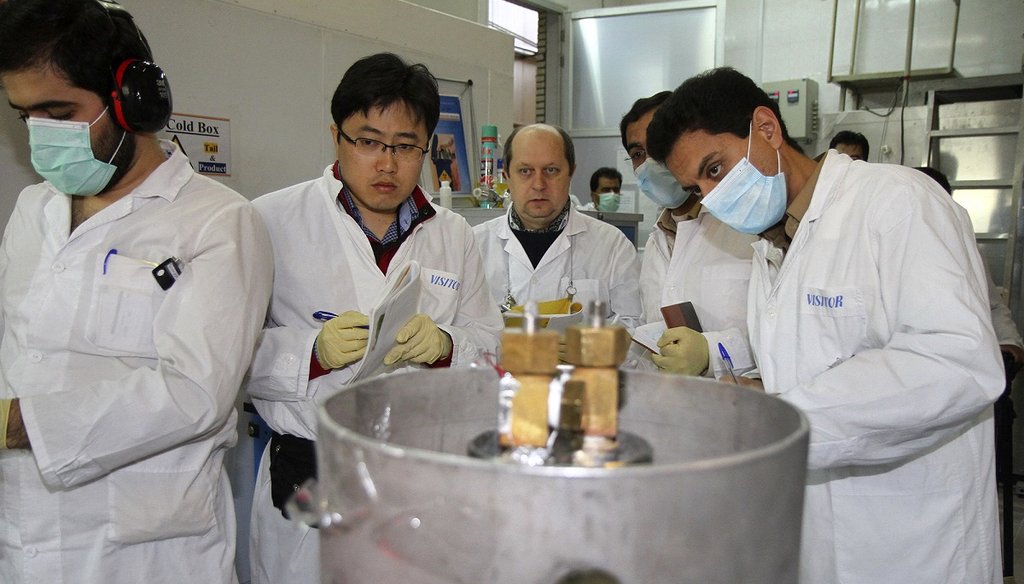Get PolitiFact in your inbox.

International Atomic Energy Agency inspectors and Iranian technicians monitor the Natanz facility in Iran on Jan. 20, 2014. (AP Photo)
With 41 Senate Democrats backing the historic agreement between Iran and five world powers, the Iran nuclear deal is on its way to becoming a done deal, notching a foreign-policy win for President Barack Obama.
Yet the debate is far from over. Republican presidential hopefuls Donald Trump and Ted Cruz, flanked by Sarah Palin, appeared at a Stop the Iran Deal Rally on Sept. 9. They and other critics say the deal gives away too much to Iran, while supporters say the alternative would be much more dangerous.
The 159-page deal may hinge on nuclear physics, but understanding the basics shouldn’t be rocket science. We’re here to help. Here are six points you need to know.
1. The deal aims to extend the time it would take for Iran to make a nuclear bomb.
Without the deal, Iran might be two to three months away from getting a nuclear bomb. With the deal, Iran commits to not pursuing nuclear weapons overall and faces obstacles if it seeks to break its commitment and pursue a nuclear weapon.
Under the deal, Iran will lose 97 percent of its stockpile of enriched uranium. It will also give up 14,000 of its 20,000 centrifuges, the machines used to enrich uranium, and agree to only enrich uranium to a level unsuitable for weapons for 15 years.
The deal also curbs Iranian production of plutonium, the other element that can be used to build a bomb. The deal bans plutonium reactors for 15 years and stipulates that Iran must dismantle its current one.
If Iran abides by these rules for 10 years, scientists say it would take them at least 12 months to build a weapon.
While specific restrictions lapse in 10, 15, or 25 years, the deal also binds Iran to permanent measures: committing to not pursue nuclear weapons and agreeing to notify the International Atomic Energy Agency when it decides to build a nuclear facility.
2. Some of Iran’s major nuclear facilities will be subject to constant monitoring, but if international inspectors suspect violations elsewhere, they may have to wait as long as 24 days.
Of course, just because Iran says it’ll agree to the restrictions doesn’t necessarily mean it will. To make sure Iran holds up its end of the bargain, the deal permits the atomic agency "to implement continuous monitoring." What that means and whether it’s enough are up for debate.
"Iran’s nuclear program will be under lock, key and camera 24 hours a day, 365 days a year," Rep. Don Beyer, D-Va., wrote in an op-ed supporting the deal.
That rates Half True. The agency will have cameras that provide 24-hour monitoring at the Natanz facility, which has 5,000 centrifuges, and inspectors will have daily access to the facility for 15 years. Within a year, there will be 130 to 150 inspectors in Iran.
But Natanz is more of the exception to the rule than the rule itself. For suspected sites where surveillance is not spelled out in the agreement, inspectors may have to wait up to 24 days for access. Some experts say that’s sufficient to detect violations, while others disagree.
3. ‘Anywhere, anytime’ inspections were never really a goal.
Many critics of the deal have suggested that the original plan was to give the atomic agency the ability to inspect Iranian facilities anywhere, anytime.
The Iran deal "violates promises the president made to the American people," said Sen. Marco Rubio, R-Fla. "It is not an anytime, anywhere inspection process."
We rated that claim Half True. Rubio has a point when he says the deal doesn’t include "anytime, anywhere" inspections, but that was not the administration’s goal, experts said. The White House typically characterizes the inspection as "very intrusive" — strong by historical standards and enough to block Iran’s path to a bomb.
"No sovereign state would agree to such an arrangement; no such access is necessary to verify compliance; and any such arrangement would waste the inspectors' resources," Daryl Kimball, executive director of the Arms Control Association, told PolitiFact.
4. As part of the agreement, the United States and other countries will lift economic sanctions against Iran on "Implementation Day" in 2016, allowing Iran access to billions of dollars.
What’s in this for Iran? For decades, the country’s economy has been crippled by various international sanctions on its nuclear, missile, energy, shipping, transportation, and financial sectors.
If Iran complies with the deal, all of the European Union and most American sanctions will be lifted. Critics of the deal say that effectively amounts to a $150 billion check, referring to the amount of Iran’s assets currently frozen in foreign banks.
That figure is the highest estimate out there and doesn’t consider Iran’s financial obligations (for example, it owes China billions for infrastructure projects). The Obama administration says a more realistic amount is $56 billion.
5. If Iran slips up, the sanctions can come back, though not without problems.
Suppose inspectors find that Iran is violating the deal. Any of the six countries then have the option to "snap back" or renew the United Nations sanctions against Iran for 10 years. The United States (or any U.N. Security Council member) can also veto a vote to prevent the snapback.
"The snapback provision allows the United States, as one of Iran’s toughest critics on the Council, to use the veto power to its advantage," according to the New York Times.
Others, however, aren’t so sure. Duke University political scientist Peter Feaver wrote in Foreign Policy: If sanctions are reinstated, that would absolve Iran of its obligations in the agreement, and the move would be unpopular with allies.
"The Iran deal does provide a mechanism for re-establishing the legal basis for international sanctions, even over and against the objections of other veto-players in the United Nations — but only the legal basis and only at great cost," Feaver writes.
6. Even if the United States were to reject the deal before implementation, the sanctions won’t work in the same way.
It’s important to remember that the United States is one of six world powers negotiating with Iran.
Two of these countries, Russia and China, "absolutely said clearly" they would not keep economic sanctions on Iran if the United States "walked away from the deal," according to Fox News host Bill O’Reilly.
O’Reilly exaggerated when he said the two countries were "absolutely clear," but his claim rates Mostly True. Both Russia and China have been ignoring some of the U.S. and European sanctions already. Russian leaders have said that if the deal falls through, they’ll only recognize U.N. sanctions against Iran, but not the U.S. or European ones.
France, Germany and Britain will likely follow suit and ease sanctions against Iran regardless of how Congress votes.
Correction: The Iran deal requires Iran to reduce its stockpile of enriched uranium by 97 percent. A previous version of this article described the reduction differently.
Our Sources
Scribd, Joint Comprehensive Plan of Action, July 14, 2015
PolitiFact, ‘The odd reality of Iran's centrifuges: Enough for a bomb, not power,’ Feb. 25
PolitiFact,John Kerry says Iran nuclear agreement 'never sunsets. There's no sunset in this agreement', Sept. 3, 2015
PolitiFact, Deal puts Iran's nuclear program under lock, key and camera 24/7, says Rep. Don Beyer, July 16, 2015
PolitiFact, Marco Rubio says Iran deal breaks 'anytime, anywhere' inspection promise by Barack Obama, July 19, 2015
PolitiFact, ‘Trump says Iran deal forces U.S. to defend Iran if it's attacked by Israel
PolitiFact, ‘Marco Rubio says Iran deal means we have to help defend Iran from Israel or other allies,’ July 23, 2015
PolitiFact, Donald Trump: Iran gets to keep $150 billion even if U.S. rejects nuclear deal, Aug. 16, 2015
PunditFact, Bill O'Reilly tells Huckabee: Russia, China 'said clearly' they would not keep Iran sanctions, July 30, 2015
New York Times, ‘Plutonium Is Unsung Concession in Iran Nuclear Deal,’ Sept. 7, 2015
New York Times, ‘Snapback’ Is an Easy Way to Reimpose Iran Penalties, July 16, 2015
New York Times, 3 More Senators Back Iran Deal, Giving White House Added Cushion, Sept. 8, 2015
CNN, ‘Iran nuclear deal full of complex issues and moving parts,’ July 14, 2015
Wall Street Journal, ‘Democratic Support for Iran Nuclear Deal Reaches Critical Threshold,’ Sept. 8, 2015
Brookings Institute, ‘Based on breakout timelines, the world is better off with the Iran nuclear deal than without it,’ July 17, 2015
The Atlantic, ‘The Real Test of the Iran Deal,’ July 28, 2015
Politico, ‘Obama secures 41 votes in support of Iran deal,’ Sept. 8, 2015








































